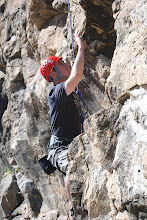
I think I need to tell this story in reverse, starting with the summit attempt and working backwards. It's like eating supper by starting with dessert; sometimes it's just better that way.
I should point out that there are many routes you can take to get up Mount Kilimanjaro so this account may be different than others. We chose the very challenging Machame route, a 67km, five day boot-camp for the summit attempt followed by a gruelling two day descent.
The route follows the "walk high, sleep low" principal of altitude training meaning that each day, climbers ascend to a higher altitude than they sleep at in the camps. This gives the body time to adjust to the extreme altitude and gives the climber the greatest possible chance for success.
Day five on the mountain began with a 5 to 6 hour trek from the Karanga Valley camp to the summit base camp, called Barafu. The camp is often under a blanket of snow and is always cold. Barafu means "ice" in Swahili.
After arriving at the camp, we spent some time re-organizing the gear in our packs, making sure we only had "the essentials" to minimize pack weight. We had a small bite to eat and hydrated the best we could on sore stomachs (courtesy of the altitude). Our guide told us to rest up as we'd be rising again at 11pm.
The wake-up call came quickly. It was cold. Very cold. We had a cup of tea and quietly gave the "good luck" nod or handshake to other climbers and friends we'd met along the way who were beginning their own migration up the steep slope.
Soon our turn came to set out from the dark camp. The pace was slow. Each step had to be chosen carefully in the light of our headlamps to keep from twisting an ankle or worse. One achingly slow step at a time, we were finally attempting the summit!
The ash/skree slope is a bit like walking in sand. That's difficult with a prosthetic limb due to the instability of the surface. I had to concentrate very hard on every step, making sure my footing was solid and not going to pitch or roll my body which would waste valuable energy in the recovery.
In this regard, my leg may have been an advantage. Having something to focus on occupied my mind and kept me from thinking about my lungs, the remaining distance or fatigue.
Around the 5000m mark we began passing other parties who were being forced to descend. Their attempt was over. Acute mountain sickness was a silent predator stalking the unlucky, not discriminating on age or fitness. None of us knew if it would strike us or if it did, when and how bad.
We passed by people doubled over in pain on the side of the track. Others were pleading with their guides to let them continue, though the sound of fluid in their lungs betrayed them. In some cases, mental or physical exhaustion had taken away the will to continue.
Groups of twelve, singing loudly at the start, were cut down to quiet groups of eight. Groups of eight were now groups of four. Whole teams were turning back. The further we climbed, the worse it got.
And then, sunrise.
The African sky cracked a tiny shard of red light on the horizon, warming us from the very soul. The glaciers to our left and below lit up like white beacons. We could see the top!
In that moment, we knew we were going to make it! With renewed hope, we leaned in and pushed to the top of Stella's point, the rim of the volcano. From there, it was a short 150m ascent to Uhuru Peak, the summit of Mount Kilimanjaro.
Arriving at the sign to take our victory photo was bitter sweet. We were reunited with friends we had made at the bottom of the mountain on the first day while we scanned new arrivals for the faces that were still missing.
It's difficult to describe the sheer emotion of reaching the top. Is it enough to say "we were pretty happy" and leave it at that?
Unfortunately our celebration had to be short lived. The increased risk of acute mountain sickness setting in at that altitude meant we had to begin our descent about twenty minutes after reaching the peak.
Physically and mentally exhausted, we now faced a four hour steep descent back down to Barafu camp to pack our gear, followed immediately by another six hour rocky descent to the Mweka base camp where we would finally get to sleep for the night.
Our goals shifted quickly. We had made it to the top, now we had to focus on getting down without getting injured.
On Machame, each day is more challenging than the last, including a near vertical "goat-track" climb up a sheer rock wall on day four. The climb down from the summit to our last base camp on day six was no exception.
By the time climbers attempt the summit from this route, they're physically and mentally prepared for the rigors of that very long, cold night. Just making it to the end of the each day felt like an accomplishment.
.JPG)




.JPG)
.JPG)
.JPG)


.JPG)
.JPG)
.JPG)
.JPG)
.JPG)
.JPG)
.JPG)
.JPG)
.JPG)




























.JPG)


